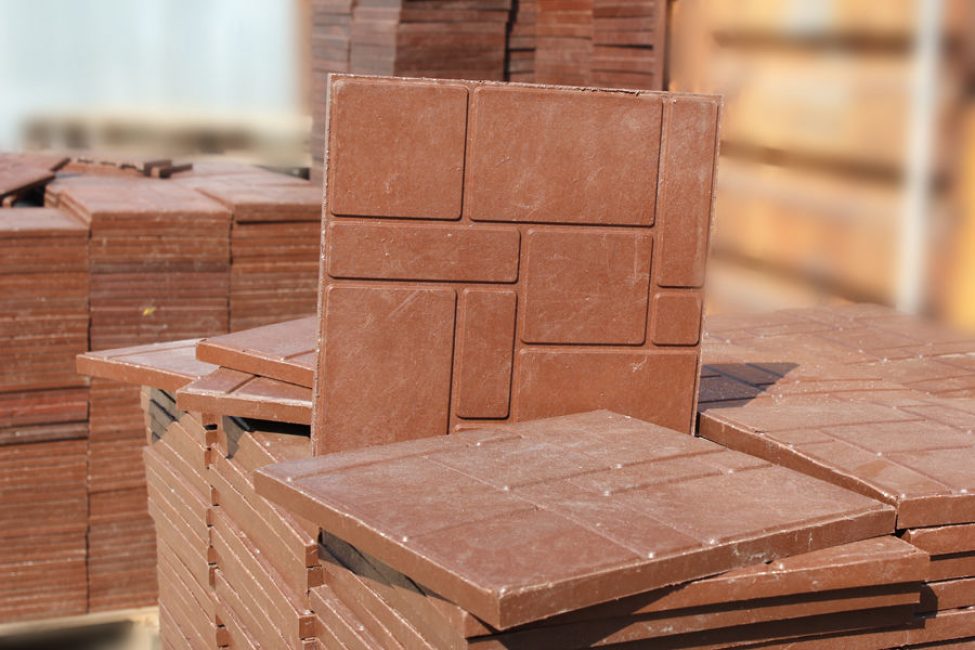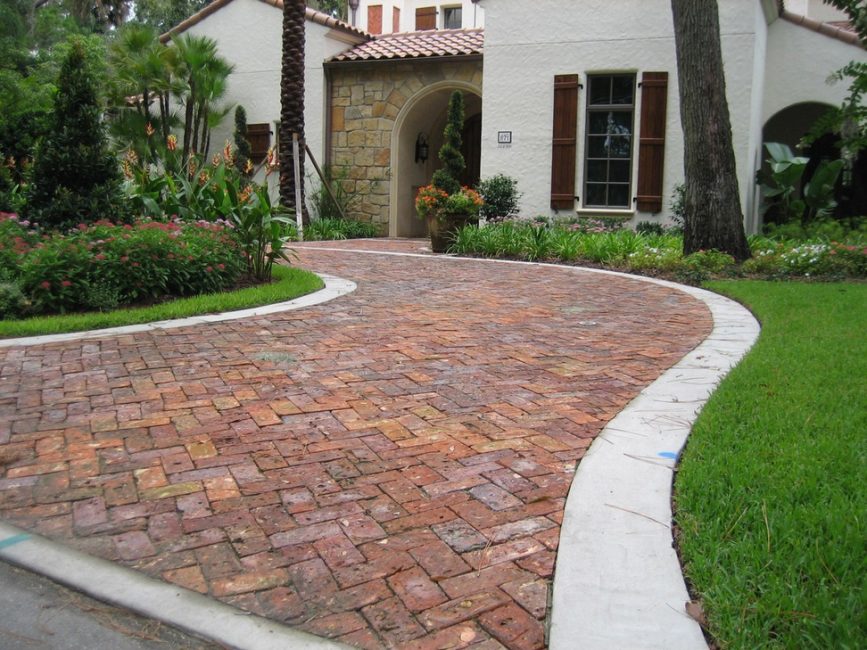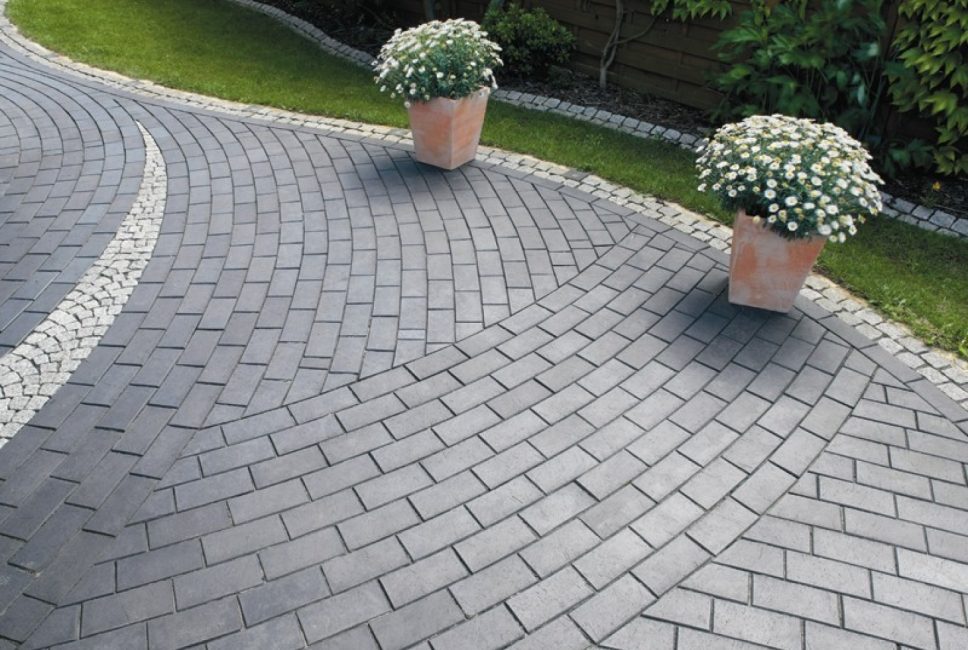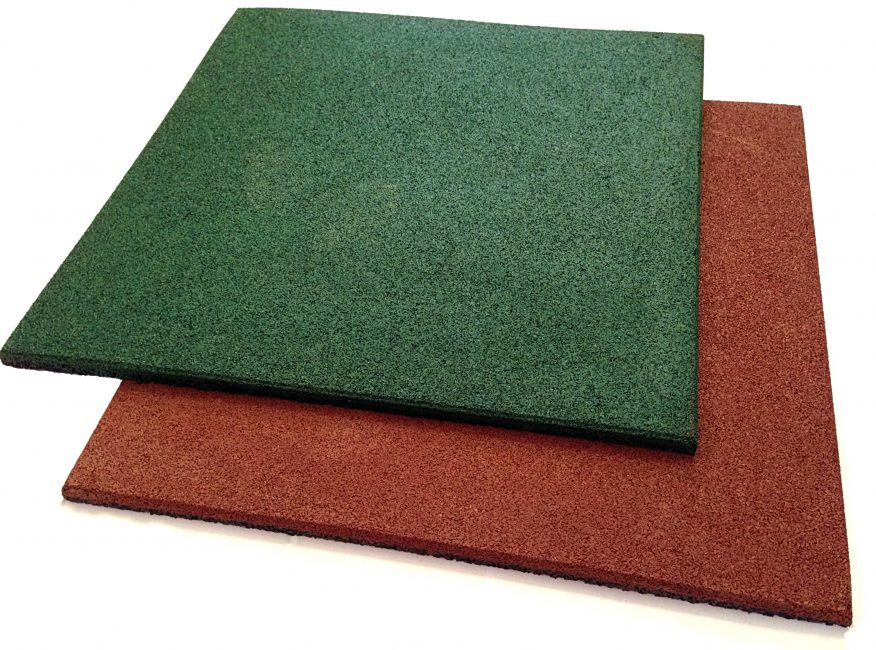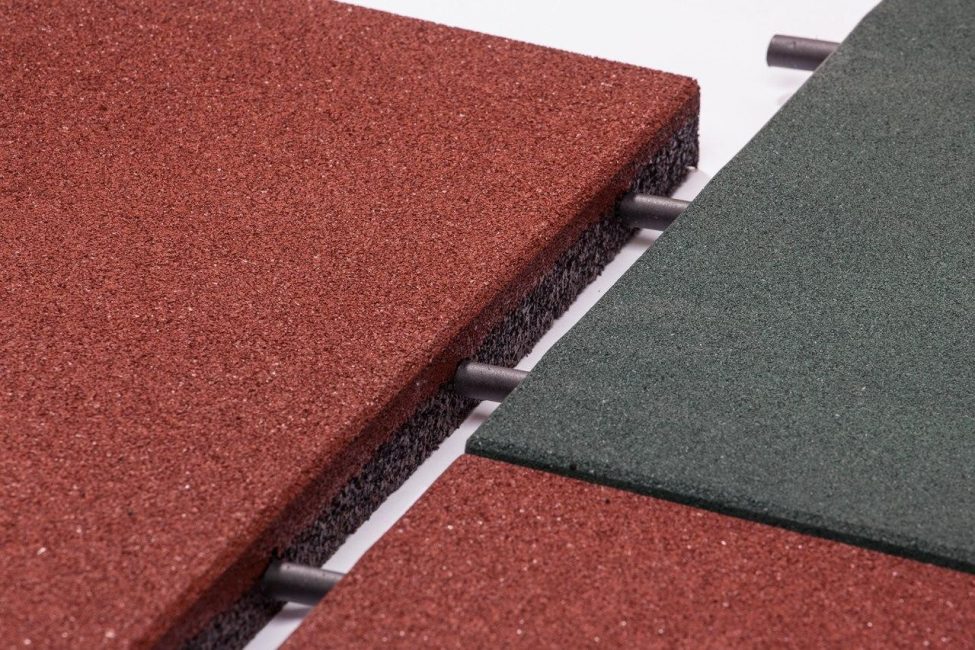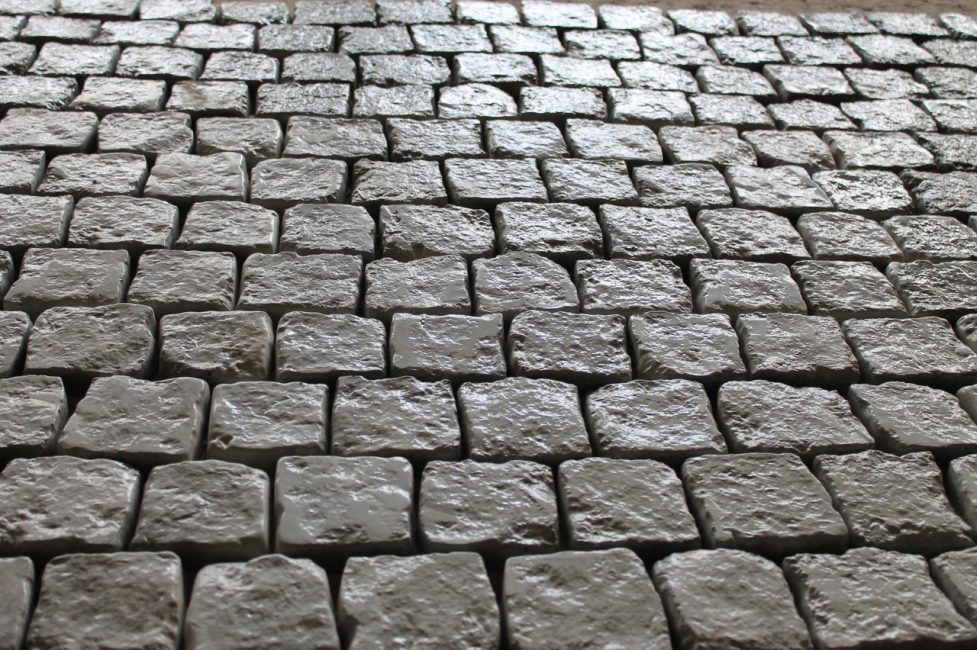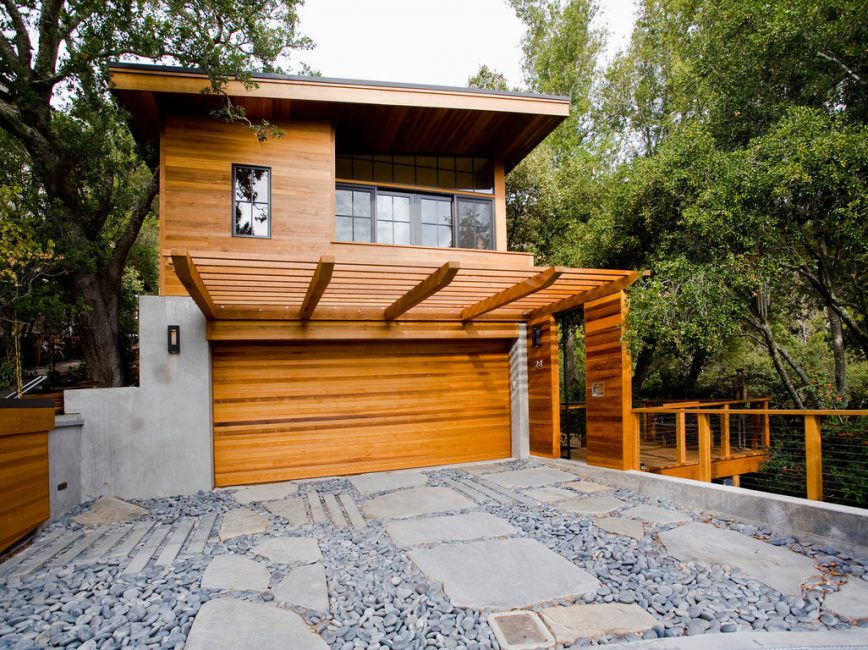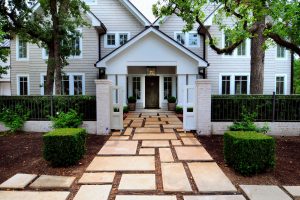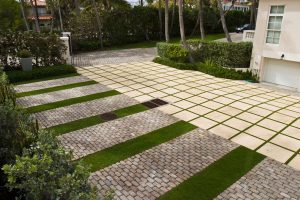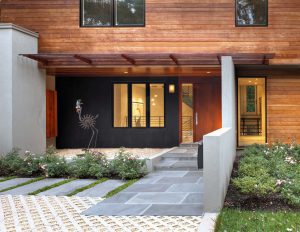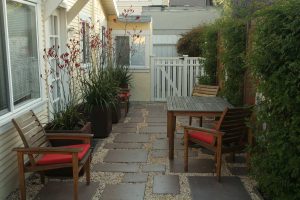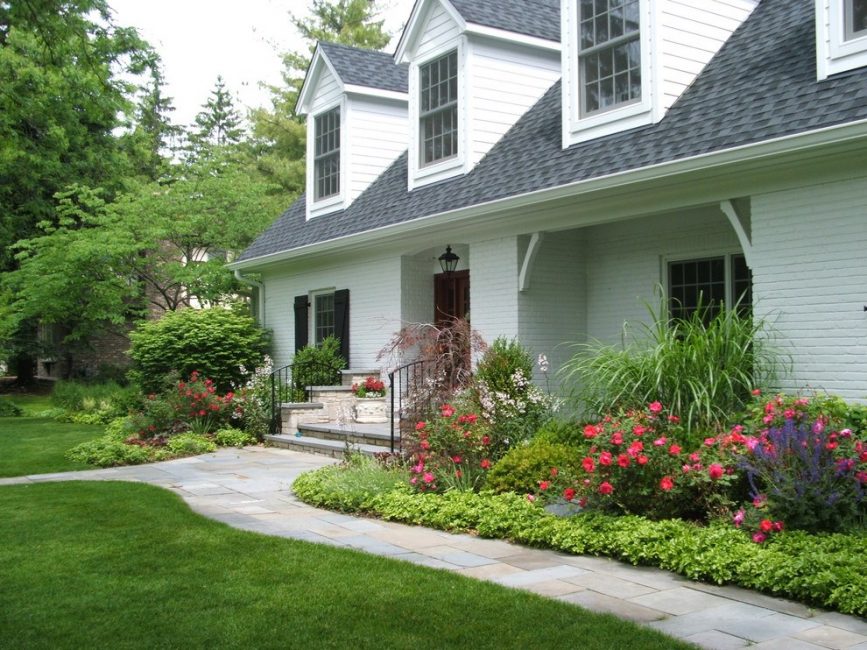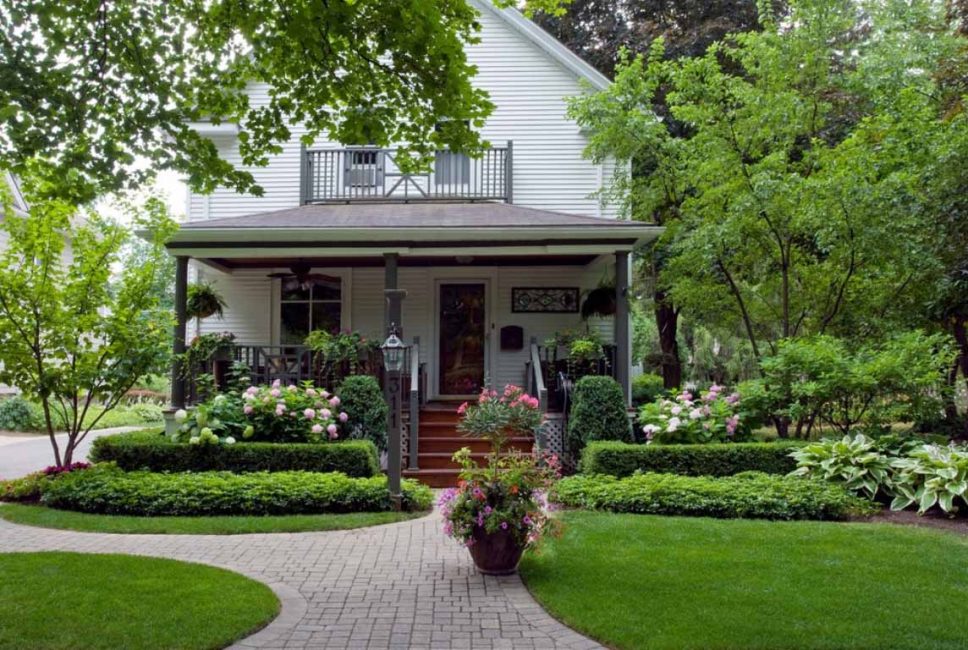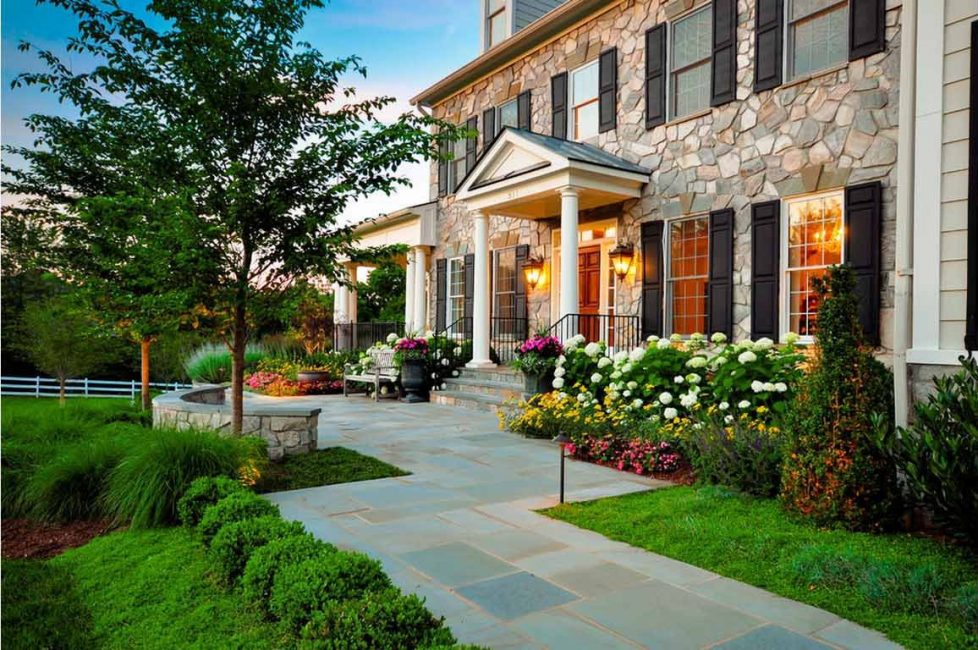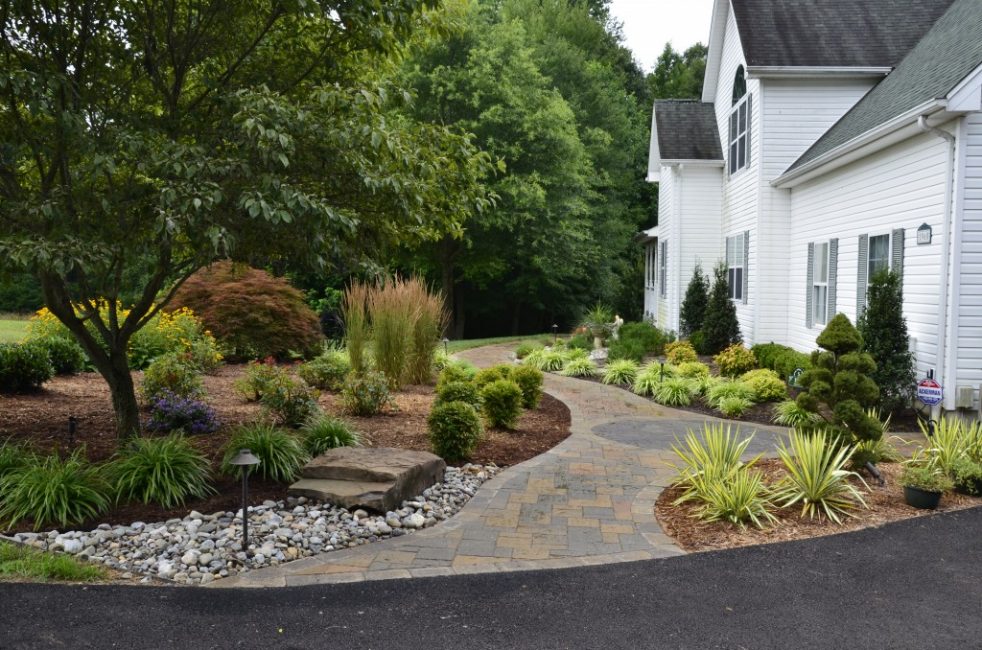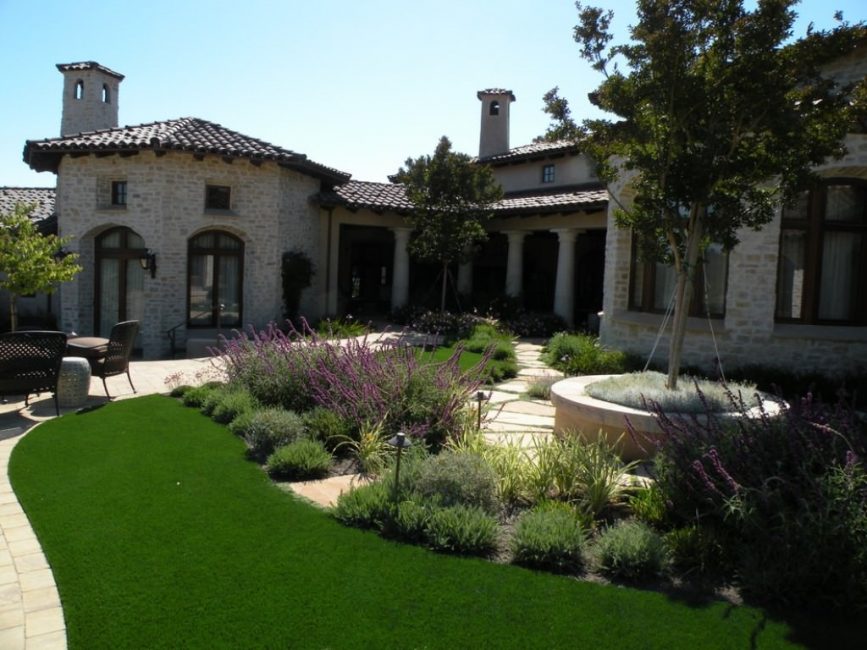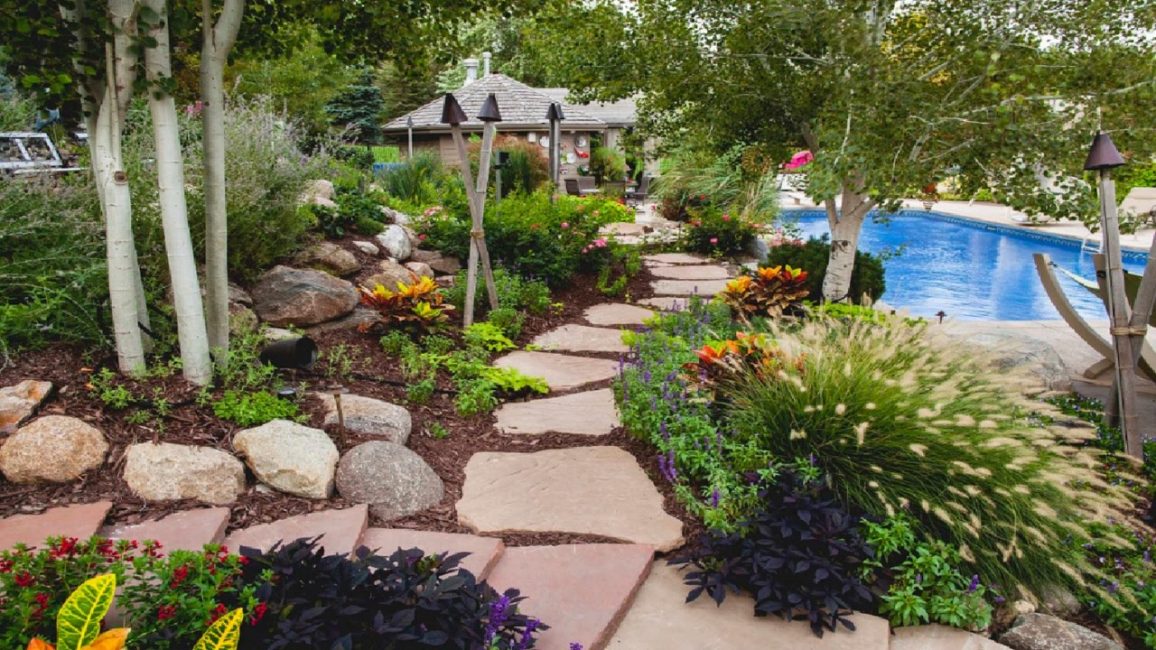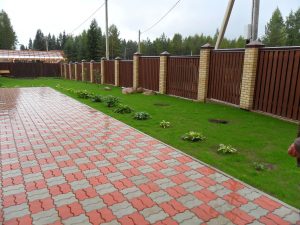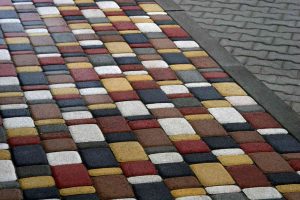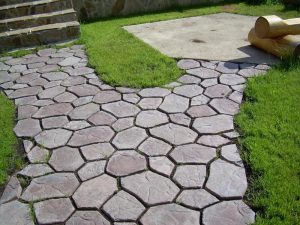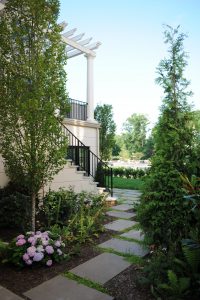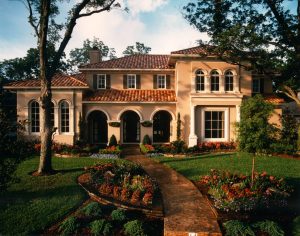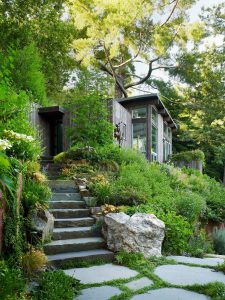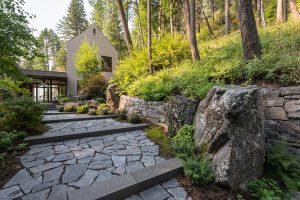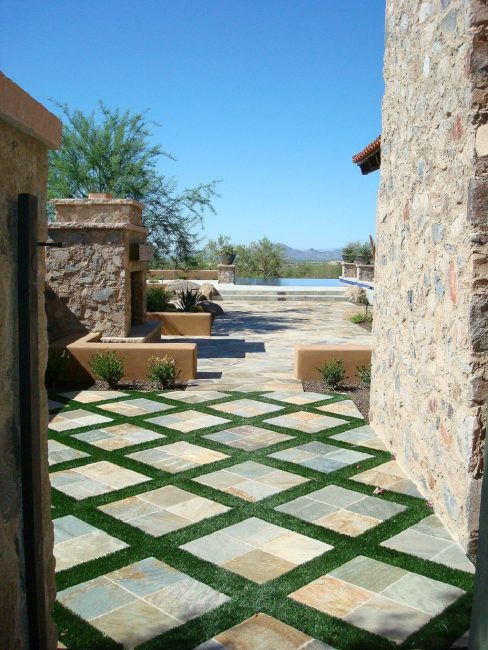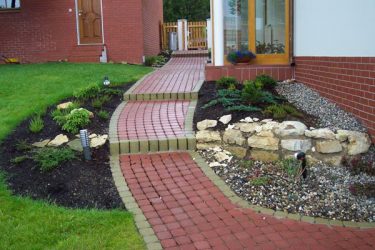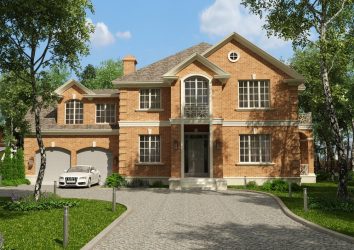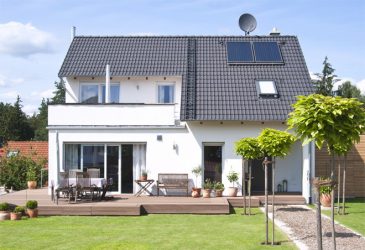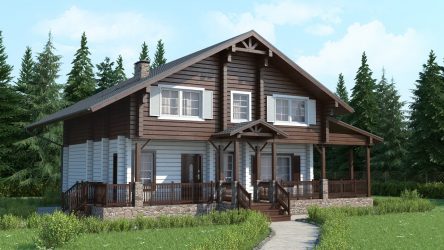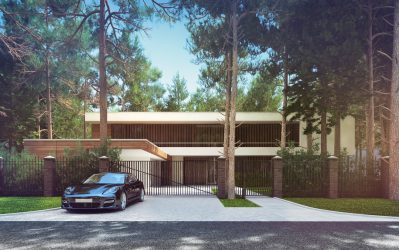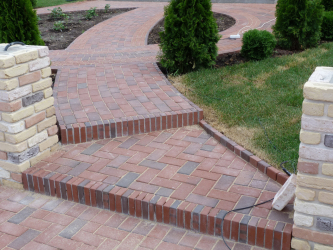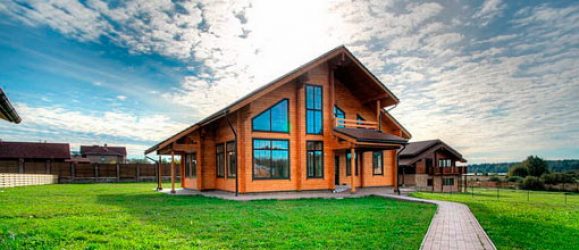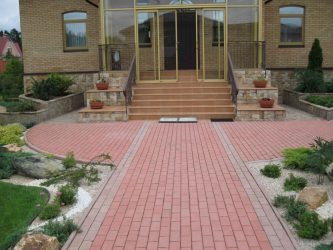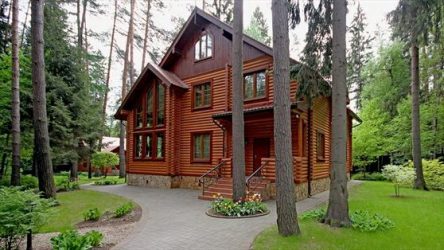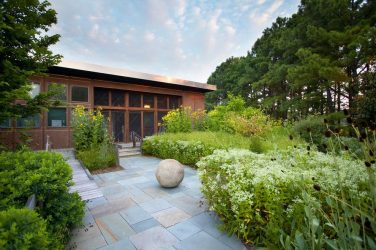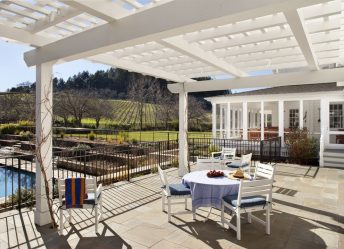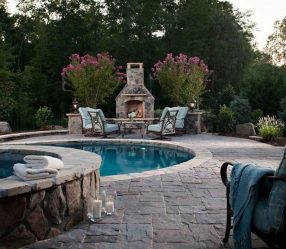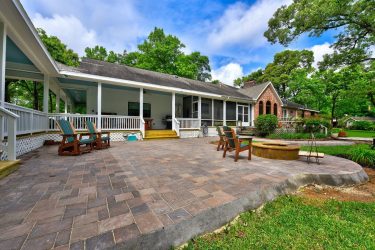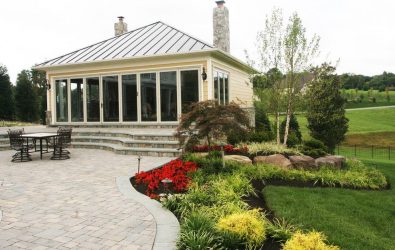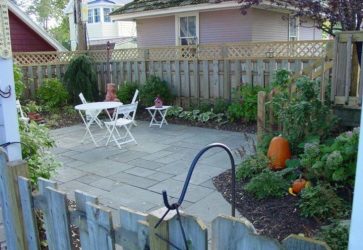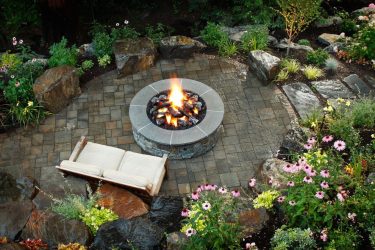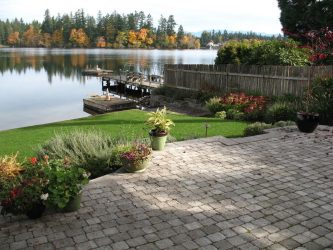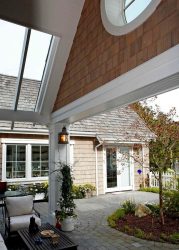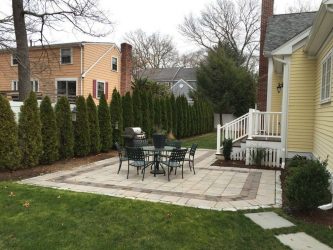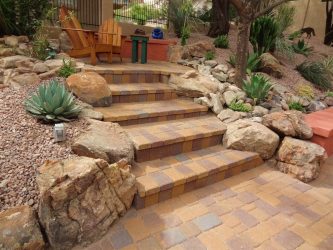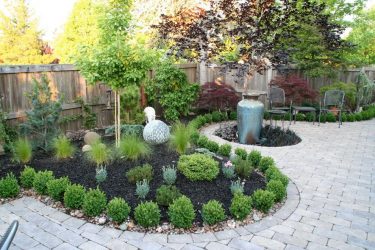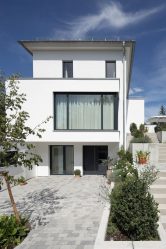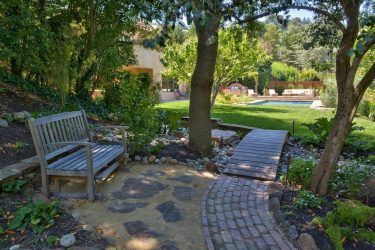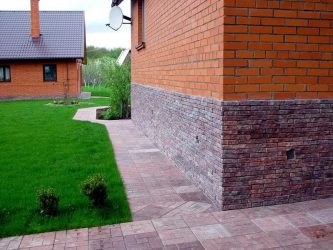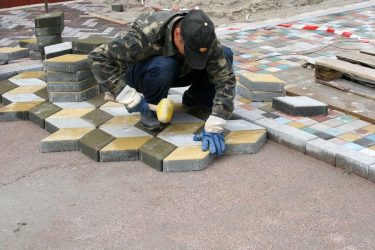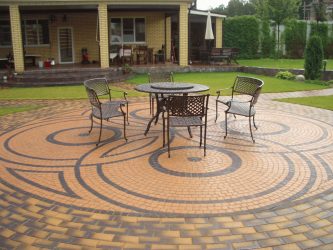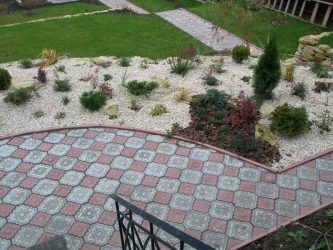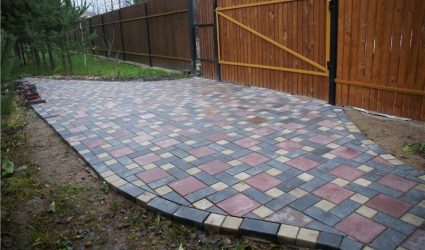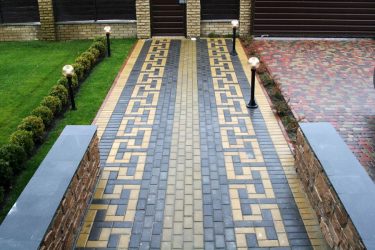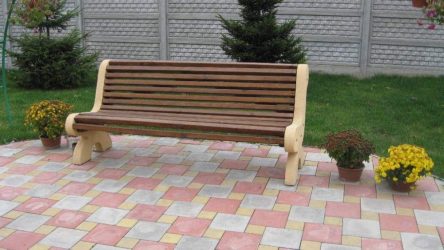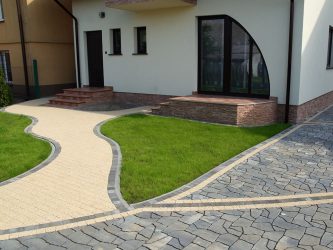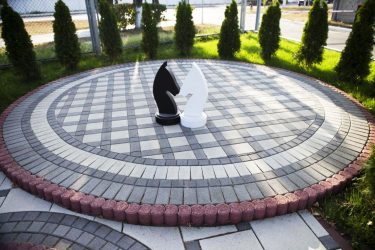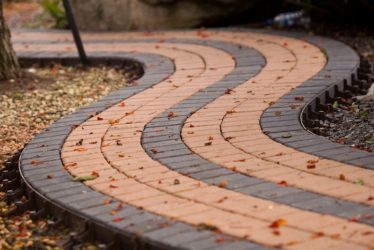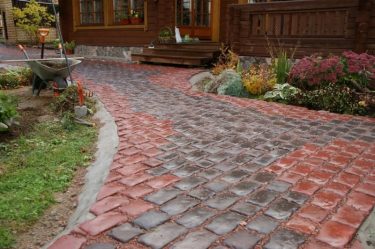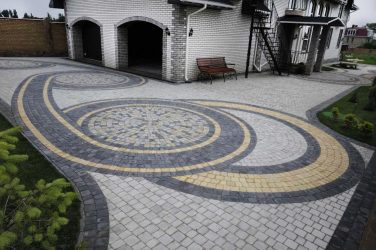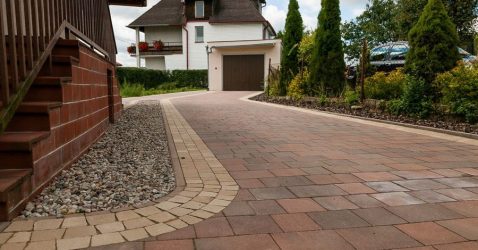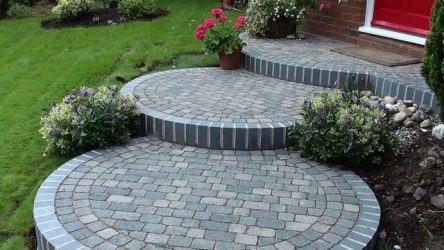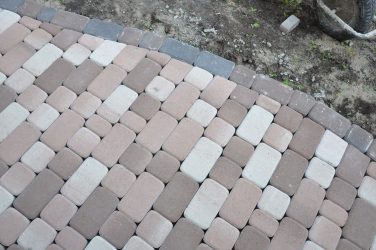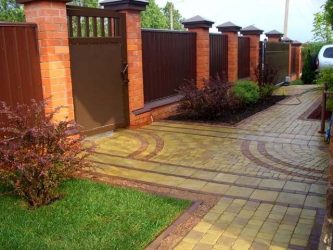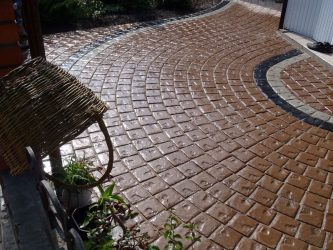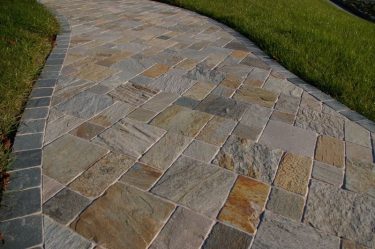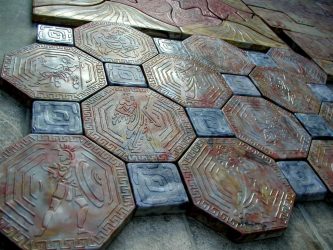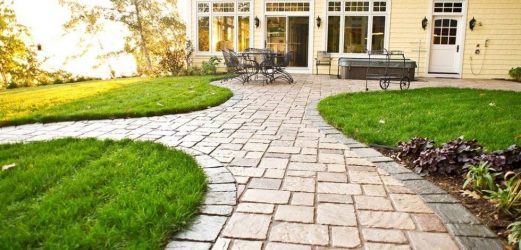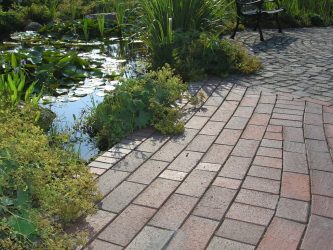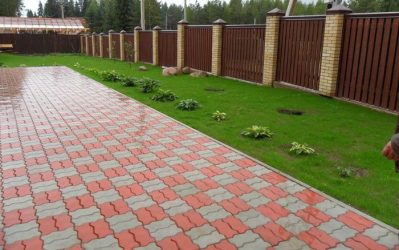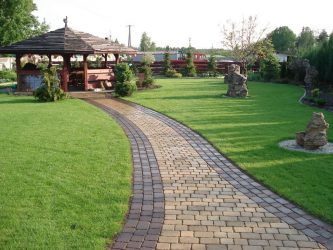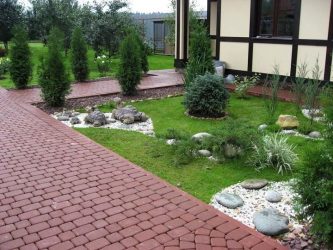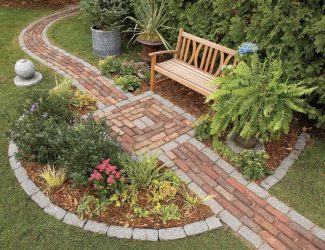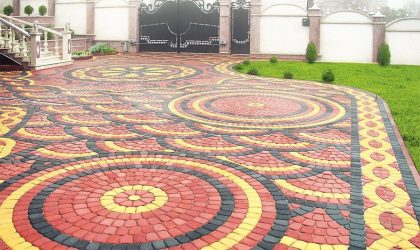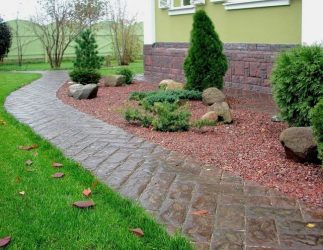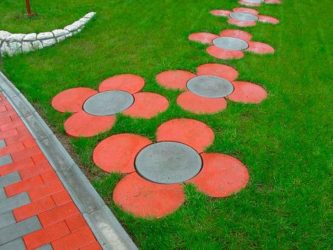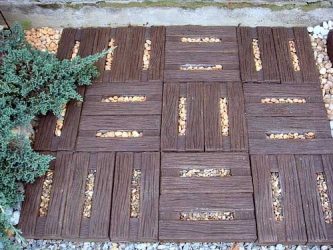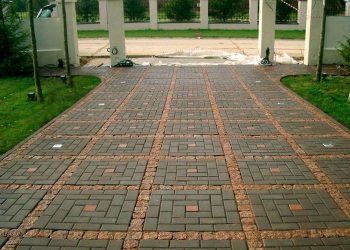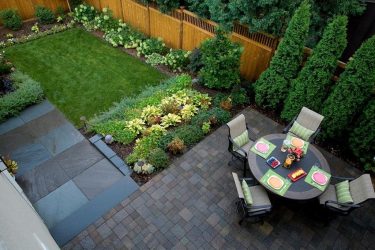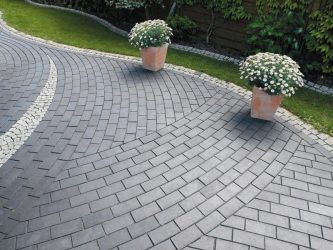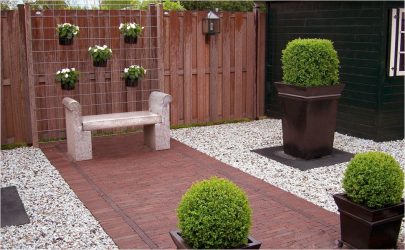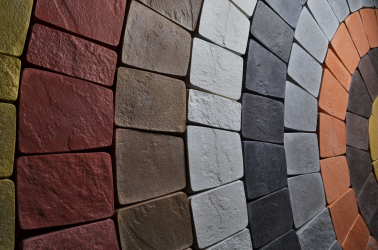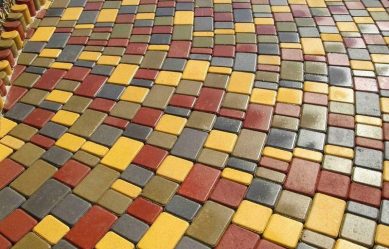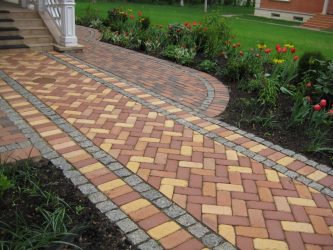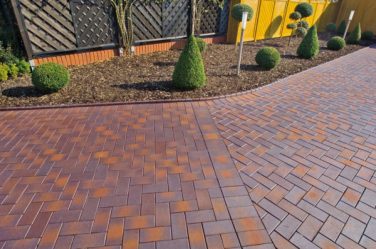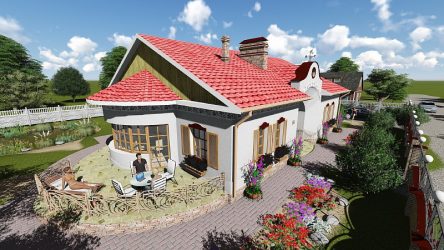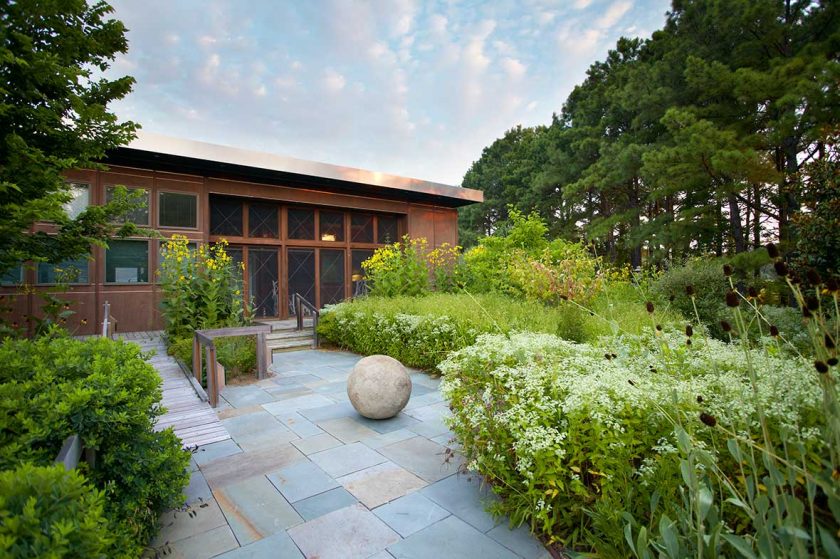
Paving tiles for tracks in the country make from a variety of materials. Rubber, wooden, stone, concrete - all have peculiar advantages and disadvantages, different types, manufacturing nuances and installation specifics that you need to be aware of in order to be able to choose. The more knowledge, the easier it is to choose the material that is suitable for your problem, making the area around the house not only utilitarian useful, but also beautiful.
Content:
Still need to take into account the color, shape, size, ways of laying, other nuances with which you can turn design planning into a creative process and the search for beautiful combinations. But the easiest to start with materials.
Tile varieties
Before buying it is important to consider all the nuances of a particular type. Consider the most current options for tiles.
return to menu ↑Plastic
Plastic - the cheapest of the existing materials in any field. It does not require complex processing, polymers for it are cheap, the performance properties as a result are not too high, but the price compensates for them.
There are different types:
The plastic tile as a whole has a list of advantages:
- Immunity to biological threats.Plastic does not rot, parasites cannot damage it, mold or fungus will not start on it.
- Immunity to moisture. Even the decking, which has a tree in its composition, calmly transfers moisture, which is important for the dacha cover.
- Immunity to mechanical damage. If you drop a heavy hammer on plastic, nothing will happen to it.
- Ease of installation. Due to the fact that plastic has fastenings, it is easy to make a single canvas - it is assembled according to the type of designer, even a person far from repair can cope with the work. If you need to disassemble the canvas, it will also be easy.
- Price. To give, on which it is a pity to spend serious sums, can be a good solution, since it is cheaper than all other materials.
- Brightness, a large selection of colors. Plastic can be given any color or pattern.
But there are also disadvantages:
- Instability to sudden changes in temperature, weather conditions. Plastic burns in the sun, cracks from the ice formed in the cracks, swells in the heat, and can deform.
- Instability to aggressive chemicals. Household acid spilled on the coating will cause it to deform.
- Instability to big weight. Man can withstand easily, but the car is gone.
- Short life. Abraded much faster than rubber and concrete coatings.
- Unaesthetic In very rare cases, a plastic tile looks good, if it is not decking.
Rubber
For the manufacture of rubber tiles use recycled materials - outdated tires. Its price is higher not only than plastic, but also than cheap clinker or concrete tiles.
Pros include:
- Security. Rubber - soft material, falling on which it is difficult to get injured. If children or elderly people have a rest in the country, the rubber tracks will be very convenient for them.
- Durability. Rubber slowly wear out, its service life is ten years.
- Ease of installation and repair. Rubber has no fastenings, like plastic, but it cannot break, does not require special alignment, it is easily replaced if some element of the finished track fails.
- Resistance to temperature and moisture. Rubber does not melt in the sun, does not crack in the cold, is completely insensitive to moisture. Not rotting.
- Low weight and resistance to mechanical damage. Rubber can not be broken, can not be crushed, easy to transport, without thinking about accuracy. It does not crack, it easily maintains the weight not only of a person, but also of a machine.
- Resistant to UV and chemicals. It will not fade in the sun, will not suffer if you spill gasoline or household acid on the track.
- Noise isolation. For tracks in the country, this factor is not so important, but if you are annoyed by loud noises, the heel clatter, the noise of steps, choosing a rubber is a good solution, since it completely muffles them.
But not a single material is perfect; rubber also has disadvantages:
- Lack of resistance to ice. In summer, rubber cannot slip even after rain, but in winter, when ice is frozen on top, it is as easy to fall on it as on a slippery stone path.
- Flammability Rubber burns, although it takes time to inflame. In the process emits black, suffocating smoke.
- Possible manufacturer’s bad faith. If the concrete tile is just fragile and it will be obvious, poorly made rubber can release harmful substances. Therefore, it is necessary to check its quality especially carefully.
From natural stone
The natural stone is made simply - it is simply crushed and leveled so that beautiful forms turned out. Apply:
- slate;
- quartzite;
- granite;
- schungite.
For people who don’t feel sorry for funds, there is an option to pave paths with marble.
The stone has its advantages:
- Durability. Natural stone is practically not abraded - it can be seen on the pavement of old cities, which was laid many centuries ago. The tracks from it are practically eternal, the maximum that can happen to them after a couple of decades of rain and snow - a beautiful even form can become somewhat more free, grass will sprout between the plates.
- Natural beauty. Natural stone is a beautiful material with which only wood can be compared. It is not painted as artificial materials, but the simplicity, the naturalness of its colors itself looks good, especially if you pick them up with taste, so that they fit the garden and buildings.
- Insensitive to moisture. Nothing will happen to the stone, even if it is half a year lying in the mud or in a puddle.
- Insensitivity to temperature changes, to ultraviolet radiation, to ice. The stone does not crack, does not fade, does not melt - nothing can happen to it.
- Reliability. The stone tile cannot be broken, a person can pass through it, or a car can pass - it can withstand any weight.
But, of course, there are drawbacks:
- Monotony coloring. Yes, natural colors of a stone are beautiful with their streaks, with their various scales, with their variety of a shade. But the brightness, which has artificial material, the abundance of flowers, with which you can put any picture or pattern, they are not peculiar.
- Great weight. Stone is a heavy material. It needs to be loaded onto a vehicle, it needs to be unloaded, it is necessary to lay out the tracks for them - all this requires human labor, time, and energy. In addition, not every foundation will stand stone.
- High price. Natural stone is an expensive material, especially some of its varieties, as a rule, the most beautiful. Using another coating can be much cheaper.
- Instability to some biological threats. Moss can grow on the stone, grow fungus or mold. In itself, this does not harm him, but it can change the overall look of the track for the worse.
- Difficulties with the form. Solid types of stone are hard to cut into tiles of the same size and shape, because they are often sold in a rather bizarre form, with many corners, with irregular bends. It will take an effort to make a decent path out of this chaos.
- Icing. There is no protection from ice near the stone, even in summer some of its varieties may slip and fall.
Clinker
Paving slabs, which came from Holland, invented in the nineteenth century. It is made of clay with an admixture of dyes - it is first formed by pushing through a hole under high pressure, then fired once. The result is high density and has a list of advantages:
- High durability. Clinker abrades almost as long and reluctantly as natural stone. You can walk on it for decades before the effect is visible.
- Durability. It can serve almost as long as natural stone. Neither the rain, nor the wind, nor the scorching sun can harm her.
- Resistance to temperature, frost. No heat, no cold, no ice will affect the clinker, nor will biological threats.
- Variety of colors, shapes. The clinker is made artificially, so it can be given any color and any shape, from banal monochromatic rectangles to fancy polygons with a complex pattern.
Clinker is a resistant material that is little inferior to natural stone in this.
It has specific minuses:
- Fragility. The disadvantage, which is completely devoid of natural stone, clinker tiles, unfortunately, is inherent in full. If you drop something heavy on it or strike it, a crack will appear on the surface, due to which the entire track element will soon crack.
- High price. Clinker is cheaper than natural stone, but more expensive than ordinary tiles and, of course, much more expensive than rubber and plastic. Putting them all the tracks on the site may be too expensive.
Clinker is available with a different surface texture: on a smooth slip easily even in summer.
Concrete
Concrete tiles are made from sand, cement, gravel and impurities that give color and durability using three main technological processes:
- Vibro casting Cement mass is prepared, poured into special forms and set on the table, which vibrates - increased strength is attached to the final product. After the formed result, right in the forms are left to mature for two days.
- Vibropressing A mass is being prepared, poured into molds and for a few seconds sent under a vibrating press, which simultaneously imparts a pattern to the upper surface. After the result is sent to cool and consider ready.
- Hyper pressing. The mass is prepared, poured into molds and put on the press so that the strength is transferred to it with pressure. After it cools and is considered finished.
The cast version is considered somewhat more fragile, but there is no big difference between the results of technological processes.
They have the same advantages:
- Variability. Many colors, many forms, patterns on the surface - concrete tile, perhaps the most diverse and can even be made to order.
- Low price. Regarding stone and clinker, concrete begins to look like a cheap solution, although, of course, it costs more than rubber and plastic.
- Sustainability. It does not suffer from temperature changes, is not subject to biological threats, does not fade in the sun, does not crack under ice, and wears off for a long time.
There are, of course, and cons:
- Relative fragility. Concrete begins to crack and crumble before clinker and natural stone - these are its characteristics. This happens especially quickly if the goods were produced in one region and used in another.
- The complexity of installation. If an error was made during the installation, it will be difficult to correct it and you will have to start from the very beginning.
Planning and Design
If you choose the material, taking into account the general idea of the site and the tastes, you will not be able to do this with the other characteristics. The design of the tile must fit the design of everything else, it must fit into the overall concept.
To make this possible, the approach to planning should be consistent:
- Make a plan of the site. On it you need to put the house, outbuildings, the largest flower beds and beds - all that has at least some relation to landscape.
- Make a plan for future tracks. The paths should lead from the house to the outbuildings and to the gate, and they should go in the same way as the inhabitants of the house, and not in the way it seems beautiful on the plan. Big obstacles to go around, take into account the "little things" like hanging over the place where the path should pass, branches.
- Rate prospects. According to the plan, you can figure out what should be the tile, so that everyone was comfortable. If the site has a well or a swimming pool, you need to take a rough texture and material that is not afraid of moisture.If the area has weak soil that crumbles easily and does not hold weight well, it is better to forget about the natural stone. Also estimate the budget of the enterprise and whether cars will drive along the lanes, think about how much the maximum temperature difference will be. What heat and what cold have to endure the path? How many will walk on it?
From how much will go, depends on the index of abrasion. From the maximum temperature and differential - the necessary frost resistance. If the car will drive along the paths, the tile should be thicker. It depends on the budget how expensive it will be.
Deciding what should be the technical characteristics, you can move on to more pleasant and complex matters: to design.
It is necessary to take into account:
- What style is made house? If it is sheathed with plastic by panelsexpensive tracks from natural stone to him will not fit. Conversely, if it is made of brick, it is undignified to surround it with plastic.
- Are growing on the site flowers, if so, which ones? Colour tracks should be combined, at least approximately, with their color.
- Are there any ideas on drawing or should the tiles be monotonous? If there are ideas, you need to carefully draw them (well, if there are more than one ideas, so that there is something to choose from), paint over and evaluate the result.
- Will you lay the tile with your own hands or hire workers? If you plan to self-styling, it is better to choose simpler patterns for the beginning and not to take a natural stone that is difficult to lay.
When the plan is ready and the final styling pattern is selected, you can take on the selection.
It will be interesting to you.:
The nuances of tile selection
First you need to navigate the exact characteristics. Size, shape, frost resistance, durability - all this you need to know before you go to the store. And directly in the store, you need to imagine how a good tile should look, how it differs from poor quality, and what documents to ask the seller.
return to menu ↑Specifications
Each tile has a set of characteristics that must be considered when purchasing. The first one is size. Exists:
- Small. This is so good because you can lay out any pattern or pattern on it on a narrow country walkway, and also because you don’t have to think much about the foundation and whether it will stand. But there is a big minus - more labor is required. After all, it is much easier to lay out three large tiles in a row than to form a row of a dozen small ones.
- Average. Universal option. The drawing will not work, but the beautiful complex pattern is quite. It is not necessary to think about the basis, laying problems should not arise either. Ten by ten centimeters is an example of a good average tile.
- Big. The patterns are only the simplest, and the foundation will have to be thought about - if it is not strong enough and even, the tile can sit on one side or crack. But if you have time and effort to prepare, and you prefer the monochromatic beauty of a geometric order to complex patterns, this is a good choice.
After the size should decide what should be the form:
- Square. For square tiles fit simple patterns - they can be laid out in a checkerboard pattern or create a semblance of a brick pattern. Best of all, if they are colorful and this will allow them to look more fun.
- Rectangular. It is also possible to lay out the chess order, but not so effectively, but the brick pattern, “herringbone”, and the laying in waves will look. Different colors can create a picture.
- Wild stone. So called tiles made of natural stone, which are made not in form, but by how the stone broke.Patterns with them will not work, and in order to form a track, you will have to make an effort. To facilitate the work, you can first hold it on paper.
- Complex forms. Clover, hexagons, circles, stars - they are all in pattern. Simply put them in accordance with the pattern.
A very small tile can be used to make a meaningful drawing, regardless of the shape - stained glass is made on the same principle. Also, if you want to do something definite, fantasy, invented on your own, for which there are no necessary forms, you can always contact the manufacturer and place an order.
It will cost twice as much as a regular product - or even five, depending on the complexity of the form.
After you select the thickness:
- Two to four centimeters. Used for walking paths. If you are going to lay paths in the country only to walk on them, this option suits you.
- Six to eight centimeters. It will withstand very intensively moving people or a car. At the cottage is hardly needed.
- From eight to ten. Maintains the weight of any cars, usually used in enterprises, gas stations and personal yards, where the car will be parked.
To give a thick tile is not exactly necessary - and this is good, because the thicker it is, the more expensive it is.
After you need to select a purely technical parameters. Abrasion resistance is indicated on the package, the higher it is, the safer will be the track that you get. Frost resistance is indicated next to it - the value indicates how many cycles the tile is able to endure freezing-defrosting cycles.
The best options indicator is more than two hundred and they should be guided.
The last parameter to pay attention to is color. It depends on him how effectively the resulting track will look.
There are many options:
- White. One of the most spectacular colors that will look good at night, in the dark. These tracks are unlikely to get lost, they will look bright and fit most styles. The only negative is that you will have to take care of the stones, otherwise they will quickly become dusty, dirty and turn gray.
- The black. It is also a spectacular option that will suit a strict house made in dark colors. On such a tile dirt is imperceptible, but in the dark the walkway will be easy to lose.
- Contrast combinations. Contrasts are best suited for patterns: combine black with white, purple with orange, and blue with yellow that's a good idea. Such paths will be clearly visible, they will look bright, attract attention to themselves.
- Shades combinations. The material allows you to take one bright color and dilute it with a shade - light or dark. This option looks simple, but with taste.
- Natural colors. The stone is beautiful in itself, but you can choose a tile made for it. If it mimics the veins well, shades of natural stone, the tracks will look both natural, neat and beautiful. You can also choose a tile that is not burned - it will have a nice dark orange or darkbrown Colour.
Deciding for yourself what the material should be for all the characteristics, you can go to the store and choose a specific batch there.
return to menu ↑What to look for when buying?
The tile must not only be suitable for the design site, it must also meet quality standards. Determining whether you are going to cheat is simple enough. Need to:
- Ask the seller for documentation. A certificate of conformity must be attached to any consignment of goods, which will confirm that it is manufactured in accordance with state standards, as well as a test certificate containing all information about durability, frost resistance and other qualities of the product. If the seller yulit, trying to change the topic, it is likely that something is wrong with the goods - it is better to go to other people.
- Check random tile from batch.Even if the product offered to you is bad, the top visible layer in the package will be done well, so that you don’t guess anything. Please get the tile from the middle - normal, especially if you are ready then to buy this particular package.
- Check for flaws. Chips, cracks, crumbling edges - all this testifies not only to low quality, but also that the goods were transported without the slightest accuracy. He can come to you in the same condition.
- Check for drying. To do this, take two tiles, gently knock one on the other. If the sound is deaf, it means that the product has dried out badly and will not be durable. Minimal damage is enough for it to crumble.
- Check the form. The tile must be the same (if it is not, of course, a natural stone with bizarre shapes), otherwise it will be difficult to lay in a pattern.
- Buy high or medium price segment. Cheap goods - cheap in relation to another of the same - are usually of low quality, will not bring you any good.
When the tile is selected, it remains only to pay the seller, take the documents, arrange delivery. After - the case for small. Guided by the plan, assemble the tracks in place.
High-quality tiles will delight you for many years. If you choose the right size, shape, material, color, if you do not miscalculate with frost resistance, wear resistance - the tracks will last for decades.
Paving slabs
Do it yourself
